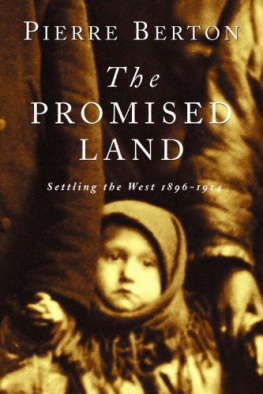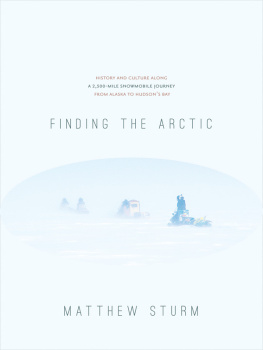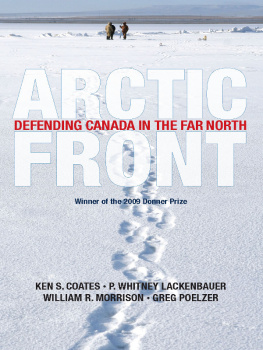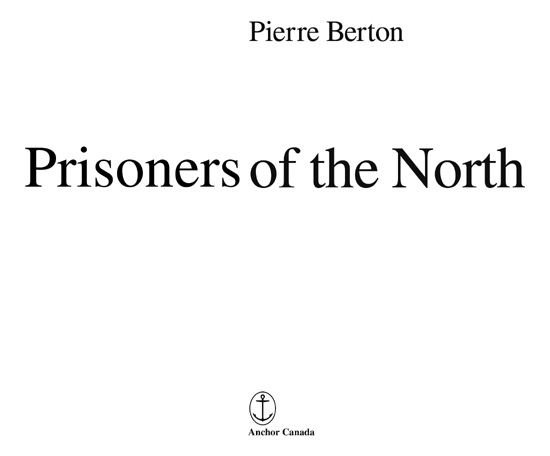You who this faint day the High North is luring
Unto her vastness, taintlessly sweet;
You who are steel-braced, straight-lipped, enduring
Dreadless in danger and dire in defeat;
Honor the High North ever and ever,
Whether she crown you or whether she slay;
Suffer her fury, cherish and love her
He who would rule her must learn to obey.
Robert W. Service
Copyright 2004 by Pierre Berton Enterprises Ltd.
Anchor Canada edition 2005
All rights reserved. The use of any part of this publication, reproduced, transmitted in any form or by any means electronic, mechanical, photocopying, recording or otherwise, or stored in a retrieval system without the prior written consent of the publisheror, in the case of photocopying or other reprographic copying, a license from the Canadian Copyright Licensing Agencyis an infringement of the copyright law.
Anchor Canada and colophon are trademarks.
Library and Archives Canada Cataloguing in Publication
Berton, Pierre, 19202004.
Prisoners of the North / Pierre Berton.
eISBN: 978-0-385-67358-7
1. Canada, NorthernBiography. 2. Northwest, CanadianBiography.
3. Canada, NorthernHistory. 4. Northwest, CanadianHistory18701905.
5. Adventure and adventurersCanada, NorthernBiography. I. Title.
FC3957.B47 2005 971.90099C C2005-901094-0
Every effort has been made to contact copyright holders for the images in this book. In the event of an inadvertent omission or error, please notify the publisher.
Published in Canada by
Anchor Canada, a division of
Random House of Canada Limited
Visit Random House of Canada Limiteds website: www.randomhouse.ca
v3.1
Books by Pierre Berton
The Royal Family
The Mysterious North
Klondike
Just Add Water and Stir
Adventures of a Columnist
Fast Fast Fast Relief
The Big Sell
The Comfortable Pew
The Cool, Crazy, Committed World of the Sixties
The Smug Minority
The National Dream
The Last Spike
Drifting Home
Hollywoods Canada
My Country
The Dionne Years
The Wild Frontier
The Invasion of Canada
Flames Across the Border
Why We Act Like Canadians
The Promised Land
Vimy
Starting Out
The Arctic Grail
The Great Depression
Niagara: A History of the Falls
My Times: Living With History
1967, The Last Good Year
Marching as to War
Cats Ive Known and Loved
The Joy of Writing
Prisoners of the North
P ICTURE B OOKS
The New City (with Henri Rossier) Remember Yesterday
The Great Railway
The Klondike Quest
Pierre Bertons Picture Book of Niagara Falls
Winter
The Great Lakes
Seacoasts
Pierre Bertons Canada
A NTHOLOGIES
Pierre and Janet Bertons Canadian Food Guide
Historic Headlines
Farewell to the Twentieth Century
Worth Repeating
Welcome to the Twenty-first Century
F ICTION
Masquerade (pseudonym Lisa Kroniuk)
B OOKS FOR Y OUNG R EADERS
The Golden Trail
The Secret World of Og
Adventures in Canadian History (22 volumes)
Maps
Drawn by CS Richardson
Contents
Foreword
In the Yukon, where I spent my childhood and much of my teens, the old-timers had a phrase for those who had been held captive by the North. Hes missed too many boats, theyd say. When the sternwheeler Casca puffed out into the grey river on her last voyage of the season toward the world we called the outside, the dock would be crammed with veterans waving goodbyemen and women who had given their hearts and their souls to the North and had no intention of leaving.
Dawson City in those days was a unique community, a cosmopolitan village where everybody knew everybody else, full of adventurous spirits who had come from every corner of the globe to profit from the great stampede of 1898. In my boyhood, the gold rush was history, but they were still here, this handful of survivors from the gaudy days.
They did not talk much about adventures that would seem prodigious to us today; it was old stuff to them. They had clawed their way up the passes, hammered together anything that would float, defied the rivers and the rapids, and notched the logs for their own cabins when at last they reached their goal. They had made it! When others flagged, or failed, or fled, they had hung on, secure in themselves, and isolated from the outside worldprisoners of their environment but free from the cacophony, and the glare, and the breathless bustle of the settled world. They had had their fill of all that. I once asked George Fraser, an old-timer who lived on Dominion Creek forty miles from Dawson, why he hadnt paid a visit to town in fifteen years. Too many bright lights! he told me. That says it all.
The North has its own sounds, but in my day when the temperature dropped and the roar of the river was stilled and the whine of the big gold dredges had ceased, the world of my youth was silent. Nothing seemed to move. Smoke rose from the chimneys in stately columns that did not waver. It was as if the entire community had been captured in a motion picture freeze frame. For many, I think, that was one of the attractions.
They came from everywhere, these old-timers we called sourdoughs. Men like Mr. Kawakami, a Dawson fixture who sold us fireworks and incense along with Japanese parasols and kimonos from his little shop on Third Avenue. A block away in her corner store, a distinguished, grey-haired Frenchwoman, Mme milie Tremblay, displayed the latest Paris fashions for the towns socialites as well as for the towns demimonde. No stranger just off the boat would have realized that in 1894, two years before gold was discovered on Bonanza and before Dawson existed, she and her husband had climbed the Chilkoot Pass and made their way into the empty Yukon.
One of her customers was the Chicago-born doyen of Dawson society, Martha Louise Black, who left her husband and climbed the Chilkoot pregnant, bore her baby in a one-room log cabin, and went on to become the second woman in Canada to win a seat in Parliament.
At St. Pauls Pro-cathedral on the Dawson waterfront I would watch the morning procession each Sunday, often led by the bishop, Isaac O. Stringer, who had been obliged to boil and consume his sealskin boots to ward off starvation on the Rat River trail, thus providing Charlie Chaplin with a memorable scene for his film The Gold Rush. At the other end of the social scale was a rough-hewn Slav, Jan Welzl, who had come to Dawson from Prague by way of the Arctic, so he claimed, with the help of the Inuit. He spent his time trying to develop a perpetual motion machine in an abandoned warehouse while bemoaning the fact that he had sold the rights to his memoirs, Thirty Years in the Golden North, for one hundred dollars before it became a Book-of-the-Month Club best-seller.
I went to school with the second and third generations of these captive Northerners. One classmate, Chester Henderson, was the grandson of the famous Robert Henderson, officially acknowledged as the co-discoverer of the Klondikes gold. Another was the son of Percy de Wolfe, known as the Iron Man of the North because of the hazards he encountered with his dog team on the mail run between Dawson and Eagle, Alaska. Helen Van Bibber, who beat me to stand first in our class, was the mixed-blood offspring of a marriage between a native Indian and a male descendant of Daniel Boone.






